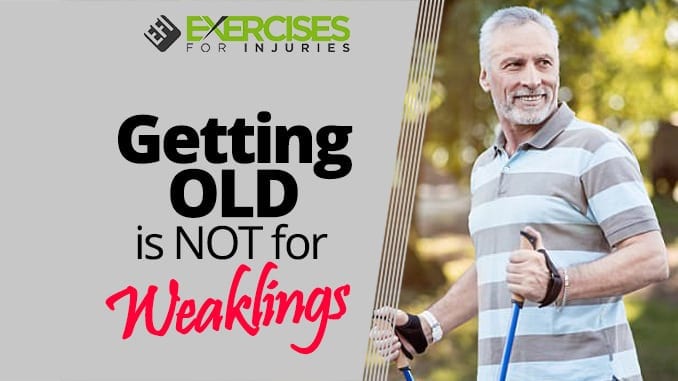As I approach 40 and see my dad approach 70, I think about this more and more. My mind is still in my twenties, and my body is in its thirties.
I know I can do what I did in my twenties, but I need to be more thoughtful about things. It is excellent to run into people like Ron.
Today, I am handing things over to Ron Kraeyewski; enjoy! Ron is an unassuming guy. You would not think much of him if you saw him, but it is fantastic to hear what he does.
This is Ron in Thailand, training at a Thailand Kickboxing gym while most people his age are on the beach. Very cool!
Getting OLD – Changes in our Body
As we get older, our bodies show unmistakable signs of aging. Our skin becomes saggy and wrinkled. Some or all hair loss is normal, along with trembling extremities, loss of coordination, and the stooped posture typical of an older individual.
As early as our thirties, we lose muscle mass, strength, and function.
Lean skeletal muscle mass may be lost at a rate of up to 5% per year, particularly the muscle cells responsible for strength and power. Our immune systems become weaker, and our metabolisms slow down while our longevity increases.
The speed at which we age is directly proportionate to the amount of activity in our lifestyle, frailty, and eventual disability, as well as the physical and dietary decisions we make each day.
Getting Old Process
As we age, we experience sarcopenia, or “poverty of flesh,” when our muscles atrophy and our limbs look hollow with excessive hanging skin and overall weakness.
Dysfunction is a sign of the times as our society engages less in physical activity, eats more processed and sugar-laced foods, and leads a sedentary life with time-saving devices.
The good news is that no signs of aging are inevitable, except for hair loss. The cure is simple but complex. High-intensity exercise, combined with resistance training, and more specifically “strength training,” is the preference over low-intensity exercises like walking.
Cardiovascular training does not qualify here, and indeed, studies have shown that it can release free radicals into our bodies and cause premature aging symptoms.
Strength training is safe for older adults and will maintain lean muscle mass and increase bone density. Workouts should focus on a complete range of motion around joints, body-weight movements, and strength training.
Age-related diseases like diabetes and dementia can be curtailed with strength training. Hormone production, such as testosterone and estrogen, will increase, and Human Growth Hormone and protein synthesis, which is a process in which cells build or manufacture proteins. Following the correct protocol, muscles will hypertrophy (enlarge) to fill out your once-flaccid skin and become much more substantial.
Getting Old Workouts
Before starting a serious strength training program, address existing problems, such as shoulder, hip, and low back injuries, and determine and correct muscle imbalances.
An educated, experienced health professional should be able to ascertain and correct those problems and instruct safe free-weight training techniques.
Free-weight training, which includes barbells, dumbbells, and kettlebells, is preferable to machine training.
Unilateral exercises (training each arm and leg individually)are better for strengthening non-dominate muscle groups and creating a uniform balance.
Low weight and high repetitions are the places to start. Still, once neural pathways have been established (no more quivering in the muscles), you must increase the resistance and lower the repetitions to manufacture true strength.
Performing 6-12 repetitions with a weight you can effectively handle will make serious strength gains.
The aging process can be slowed down and even reversed. The old expression “use it or lose it” still holds and applies even more as we age.
Ron Krayewski has been training clients since 1969. He has been certified by the NSCA as a “strength & conditioning specialist” since 1995.
Having reached the prime age of 65, he is considered the go-to trainer for seniors. Ron Krayewski currently lives and trains at Lake Chapala, Mexico. His website is www.senioronlinefitness.com .
Thanks so much, Ron.
Great information and very motivating.
Rick Kaselj, MS
If you liked the above, you might want to check out the Importance of Balance Training interview I did with Dr. Dan Ritchie.
The article, The Mature Market, may be of interest to you.

